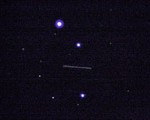![]() LISTEN to this week’s Sky Report
LISTEN to this week’s Sky Report
 Video of asteroid 2005 YU55 captured with Griffith Observatory’s 9.25-inch Celestron Equivalency Telescope on the night of November 8, 2011 (approximately 9:00 p.m., P.S.T–November 9, 5h UT). Griffith Observatory video by Anthony Cook and Matthew Burlando
Video of asteroid 2005 YU55 captured with Griffith Observatory’s 9.25-inch Celestron Equivalency Telescope on the night of November 8, 2011 (approximately 9:00 p.m., P.S.T–November 9, 5h UT). Griffith Observatory video by Anthony Cook and Matthew Burlando
Here is what’s happening in the skies of Southern California:
The waxing gibbous moon is close to brilliant planet Jupiter on Wednesday night, November 9. The moon is full on the following evening and is visible all night long. Moon- rise will happen about an hour later each following night. By Tuesday, November 15, it will rise at 9:04 p.m., allowing about 2½ hours of moon-free observing after twilight ends.
Venus is bright and very low above the west-southwest horizon during evening twilight. Look between 5:30 and 6:00 p.m. to see the innermost planet, Mercury, about 2 degrees to the lower left of Venus. Binoculars will help you to spot it.
As the moon gradually leaves the evening sky, conditions will improve for spotting comet Garradd (c/2009 P1). The comet is nearly stationary in southeast Hercules. This region is 30 degrees high in the west when darkness falls. Through binoculars, comet Garradd appears as a fuzzy star of between magnitudes 6 and 7 from wilderness areas free from light pollution. A telescope will reveal the comet’s short tail.
Finder charts for current bright comets are available online from http://skyandtelescope.com, www.heavens-above.com, and http://www.shopplaza.nl/astro/.
The orange-hued planet Mars is now the brightest object in Leo the Lion, high in the southeast when dawn starts. On Thursday morning, November 10, Mars will be in conjunction with–and 1.6 degrees north of–Leo’s brightest star, Regulus.
China’s new test space station, consisting of Tiangong-1 and Shenzhou 8, will make a pass high over Los Angeles on Monday evening, November 14. The currently unmanned station will cross the sky from southwest to east-northeast between 5:27 and 5:32 p.m., P.S.T., and will appear 76 degrees high in the south-southeast at 5:30. Keep an eye out for a “double satellite” as Shenzhou 8 is expected to automatically undock from, fly around, and re-dock with Tiangong-1. Satellite visibility for places other than Los Angeles is available at www.heavens-above.com.
Free public viewing of the sun during the day and of the moon, planets, and other celestial objects at night, is available in clear weather five days a week (Wednesday through Sunday) through Griffith Observatory’s telescopes before 9:45 p.m. Check our website for our schedule. The next public star party of the Los Angeles Astronomical Society and the Sidewalk Astronomers is scheduled for Saturday, December 3.
The Sky Report is updated every Wednesday. From Griffith Observatory, I’m Anthony Cook, and I can be reached at griffithobserver@gmail.com.
